Detailed Analysis of Boeing 787 Dreamliner Project Failure: A Report
VerifiedAdded on 2020/01/23
|16
|5465
|511
Report
AI Summary
This report provides a comprehensive analysis of the Boeing 787 Dreamliner project failure, exploring the various factors that contributed to its challenges. The introduction provides a project background and outlines the business case, objectives, and scope. The deliverables of the project, including higher cabin pressure and humidity, increased space, and fuel efficiency, are discussed. The report then delves into the constraints, assumptions, and key dates and milestones associated with the project. A detailed risk analysis, along with prevention, management, and monitoring strategies, is also presented. The report examines the roles of the project manager, sponsor, board, and team. The primary causes of failure are attributed to outsourcing decisions, complex supply chains, and technical issues. The project experienced significant delays and cost overruns. The report concludes with a summary of the lessons learned from this project failure.
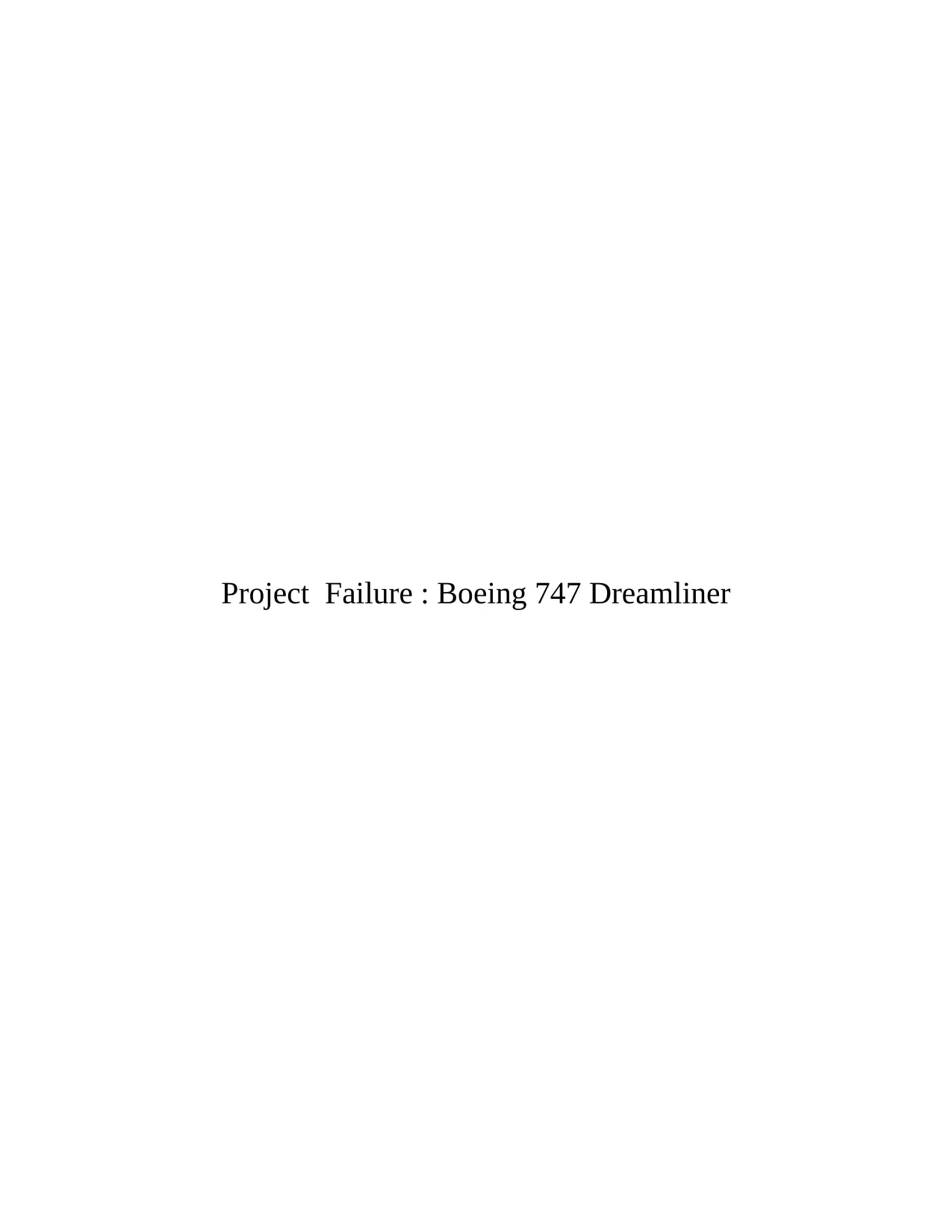
Project Failure : Boeing 747 Dreamliner
Paraphrase This Document
Need a fresh take? Get an instant paraphrase of this document with our AI Paraphraser
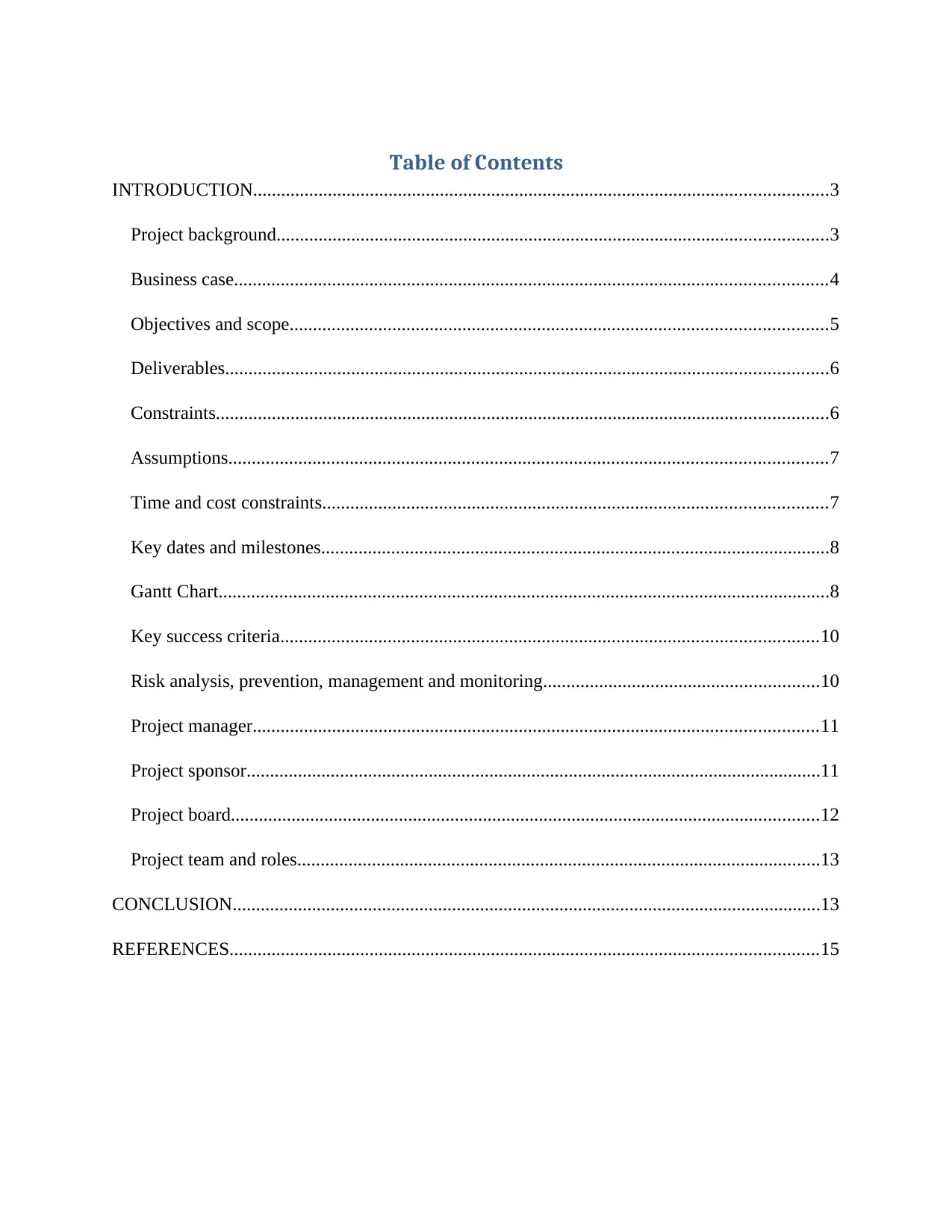
Table of Contents
INTRODUCTION...........................................................................................................................3
Project background......................................................................................................................3
Business case...............................................................................................................................4
Objectives and scope...................................................................................................................5
Deliverables.................................................................................................................................6
Constraints...................................................................................................................................6
Assumptions................................................................................................................................7
Time and cost constraints............................................................................................................7
Key dates and milestones.............................................................................................................8
Gantt Chart...................................................................................................................................8
Key success criteria...................................................................................................................10
Risk analysis, prevention, management and monitoring...........................................................10
Project manager.........................................................................................................................11
Project sponsor...........................................................................................................................11
Project board..............................................................................................................................12
Project team and roles................................................................................................................13
CONCLUSION..............................................................................................................................13
REFERENCES..............................................................................................................................15
INTRODUCTION...........................................................................................................................3
Project background......................................................................................................................3
Business case...............................................................................................................................4
Objectives and scope...................................................................................................................5
Deliverables.................................................................................................................................6
Constraints...................................................................................................................................6
Assumptions................................................................................................................................7
Time and cost constraints............................................................................................................7
Key dates and milestones.............................................................................................................8
Gantt Chart...................................................................................................................................8
Key success criteria...................................................................................................................10
Risk analysis, prevention, management and monitoring...........................................................10
Project manager.........................................................................................................................11
Project sponsor...........................................................................................................................11
Project board..............................................................................................................................12
Project team and roles................................................................................................................13
CONCLUSION..............................................................................................................................13
REFERENCES..............................................................................................................................15
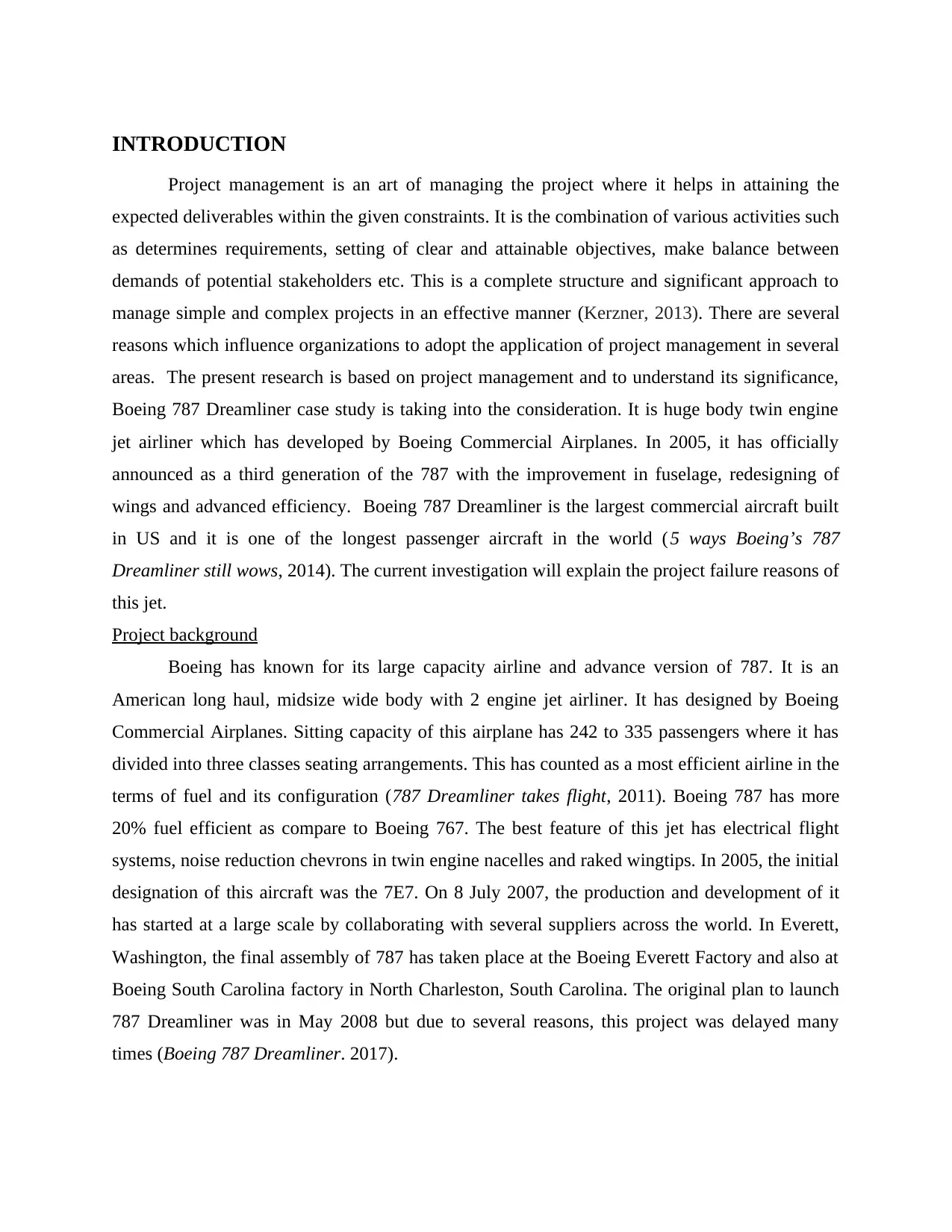
INTRODUCTION
Project management is an art of managing the project where it helps in attaining the
expected deliverables within the given constraints. It is the combination of various activities such
as determines requirements, setting of clear and attainable objectives, make balance between
demands of potential stakeholders etc. This is a complete structure and significant approach to
manage simple and complex projects in an effective manner (Kerzner, 2013). There are several
reasons which influence organizations to adopt the application of project management in several
areas. The present research is based on project management and to understand its significance,
Boeing 787 Dreamliner case study is taking into the consideration. It is huge body twin engine
jet airliner which has developed by Boeing Commercial Airplanes. In 2005, it has officially
announced as a third generation of the 787 with the improvement in fuselage, redesigning of
wings and advanced efficiency. Boeing 787 Dreamliner is the largest commercial aircraft built
in US and it is one of the longest passenger aircraft in the world (5 ways Boeing’s 787
Dreamliner still wows, 2014). The current investigation will explain the project failure reasons of
this jet.
Project background
Boeing has known for its large capacity airline and advance version of 787. It is an
American long haul, midsize wide body with 2 engine jet airliner. It has designed by Boeing
Commercial Airplanes. Sitting capacity of this airplane has 242 to 335 passengers where it has
divided into three classes seating arrangements. This has counted as a most efficient airline in the
terms of fuel and its configuration (787 Dreamliner takes flight, 2011). Boeing 787 has more
20% fuel efficient as compare to Boeing 767. The best feature of this jet has electrical flight
systems, noise reduction chevrons in twin engine nacelles and raked wingtips. In 2005, the initial
designation of this aircraft was the 7E7. On 8 July 2007, the production and development of it
has started at a large scale by collaborating with several suppliers across the world. In Everett,
Washington, the final assembly of 787 has taken place at the Boeing Everett Factory and also at
Boeing South Carolina factory in North Charleston, South Carolina. The original plan to launch
787 Dreamliner was in May 2008 but due to several reasons, this project was delayed many
times (Boeing 787 Dreamliner. 2017).
Project management is an art of managing the project where it helps in attaining the
expected deliverables within the given constraints. It is the combination of various activities such
as determines requirements, setting of clear and attainable objectives, make balance between
demands of potential stakeholders etc. This is a complete structure and significant approach to
manage simple and complex projects in an effective manner (Kerzner, 2013). There are several
reasons which influence organizations to adopt the application of project management in several
areas. The present research is based on project management and to understand its significance,
Boeing 787 Dreamliner case study is taking into the consideration. It is huge body twin engine
jet airliner which has developed by Boeing Commercial Airplanes. In 2005, it has officially
announced as a third generation of the 787 with the improvement in fuselage, redesigning of
wings and advanced efficiency. Boeing 787 Dreamliner is the largest commercial aircraft built
in US and it is one of the longest passenger aircraft in the world (5 ways Boeing’s 787
Dreamliner still wows, 2014). The current investigation will explain the project failure reasons of
this jet.
Project background
Boeing has known for its large capacity airline and advance version of 787. It is an
American long haul, midsize wide body with 2 engine jet airliner. It has designed by Boeing
Commercial Airplanes. Sitting capacity of this airplane has 242 to 335 passengers where it has
divided into three classes seating arrangements. This has counted as a most efficient airline in the
terms of fuel and its configuration (787 Dreamliner takes flight, 2011). Boeing 787 has more
20% fuel efficient as compare to Boeing 767. The best feature of this jet has electrical flight
systems, noise reduction chevrons in twin engine nacelles and raked wingtips. In 2005, the initial
designation of this aircraft was the 7E7. On 8 July 2007, the production and development of it
has started at a large scale by collaborating with several suppliers across the world. In Everett,
Washington, the final assembly of 787 has taken place at the Boeing Everett Factory and also at
Boeing South Carolina factory in North Charleston, South Carolina. The original plan to launch
787 Dreamliner was in May 2008 but due to several reasons, this project was delayed many
times (Boeing 787 Dreamliner. 2017).
⊘ This is a preview!⊘
Do you want full access?
Subscribe today to unlock all pages.

Trusted by 1+ million students worldwide
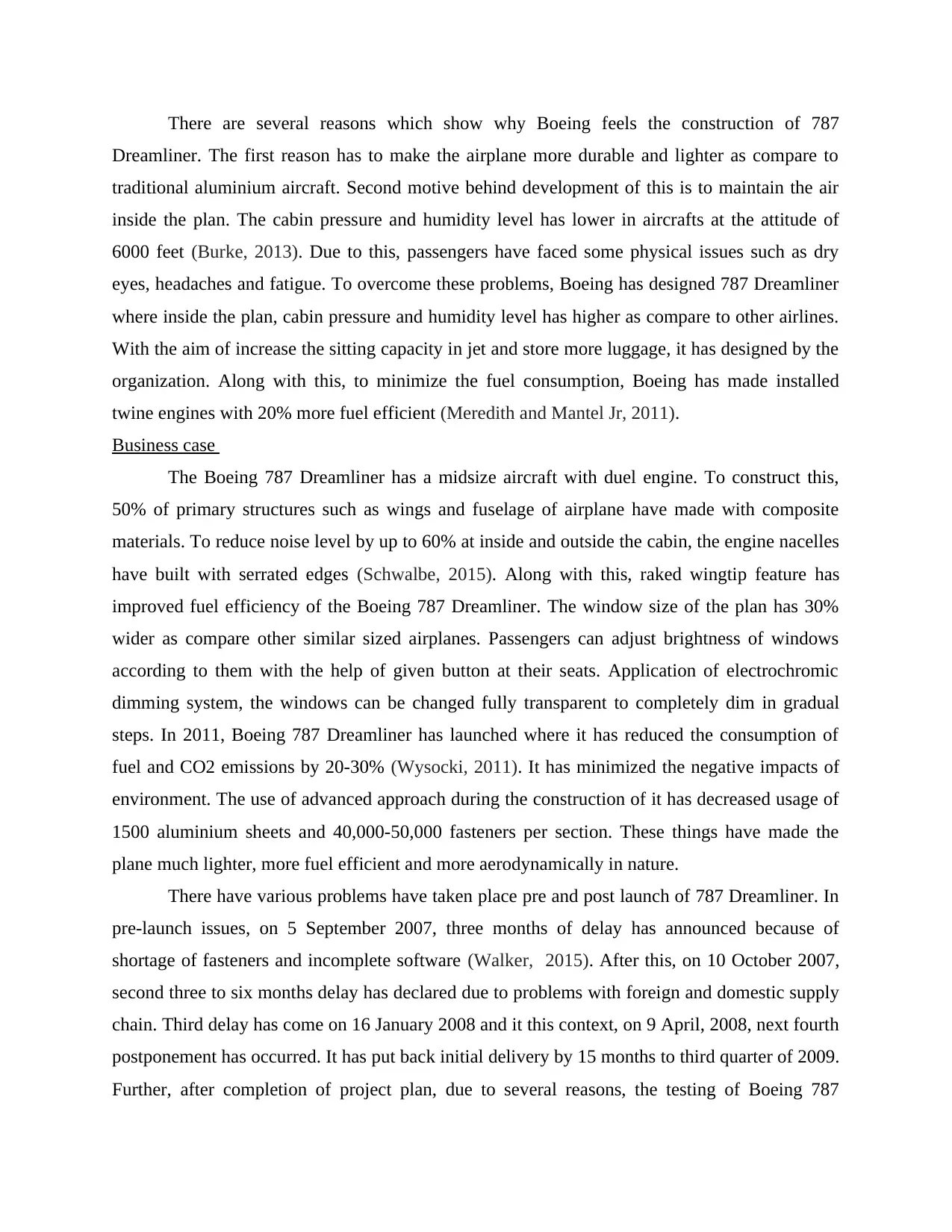
There are several reasons which show why Boeing feels the construction of 787
Dreamliner. The first reason has to make the airplane more durable and lighter as compare to
traditional aluminium aircraft. Second motive behind development of this is to maintain the air
inside the plan. The cabin pressure and humidity level has lower in aircrafts at the attitude of
6000 feet (Burke, 2013). Due to this, passengers have faced some physical issues such as dry
eyes, headaches and fatigue. To overcome these problems, Boeing has designed 787 Dreamliner
where inside the plan, cabin pressure and humidity level has higher as compare to other airlines.
With the aim of increase the sitting capacity in jet and store more luggage, it has designed by the
organization. Along with this, to minimize the fuel consumption, Boeing has made installed
twine engines with 20% more fuel efficient (Meredith and Mantel Jr, 2011).
Business case
The Boeing 787 Dreamliner has a midsize aircraft with duel engine. To construct this,
50% of primary structures such as wings and fuselage of airplane have made with composite
materials. To reduce noise level by up to 60% at inside and outside the cabin, the engine nacelles
have built with serrated edges (Schwalbe, 2015). Along with this, raked wingtip feature has
improved fuel efficiency of the Boeing 787 Dreamliner. The window size of the plan has 30%
wider as compare other similar sized airplanes. Passengers can adjust brightness of windows
according to them with the help of given button at their seats. Application of electrochromic
dimming system, the windows can be changed fully transparent to completely dim in gradual
steps. In 2011, Boeing 787 Dreamliner has launched where it has reduced the consumption of
fuel and CO2 emissions by 20-30% (Wysocki, 2011). It has minimized the negative impacts of
environment. The use of advanced approach during the construction of it has decreased usage of
1500 aluminium sheets and 40,000-50,000 fasteners per section. These things have made the
plane much lighter, more fuel efficient and more aerodynamically in nature.
There have various problems have taken place pre and post launch of 787 Dreamliner. In
pre-launch issues, on 5 September 2007, three months of delay has announced because of
shortage of fasteners and incomplete software (Walker, 2015). After this, on 10 October 2007,
second three to six months delay has declared due to problems with foreign and domestic supply
chain. Third delay has come on 16 January 2008 and it this context, on 9 April, 2008, next fourth
postponement has occurred. It has put back initial delivery by 15 months to third quarter of 2009.
Further, after completion of project plan, due to several reasons, the testing of Boeing 787
Dreamliner. The first reason has to make the airplane more durable and lighter as compare to
traditional aluminium aircraft. Second motive behind development of this is to maintain the air
inside the plan. The cabin pressure and humidity level has lower in aircrafts at the attitude of
6000 feet (Burke, 2013). Due to this, passengers have faced some physical issues such as dry
eyes, headaches and fatigue. To overcome these problems, Boeing has designed 787 Dreamliner
where inside the plan, cabin pressure and humidity level has higher as compare to other airlines.
With the aim of increase the sitting capacity in jet and store more luggage, it has designed by the
organization. Along with this, to minimize the fuel consumption, Boeing has made installed
twine engines with 20% more fuel efficient (Meredith and Mantel Jr, 2011).
Business case
The Boeing 787 Dreamliner has a midsize aircraft with duel engine. To construct this,
50% of primary structures such as wings and fuselage of airplane have made with composite
materials. To reduce noise level by up to 60% at inside and outside the cabin, the engine nacelles
have built with serrated edges (Schwalbe, 2015). Along with this, raked wingtip feature has
improved fuel efficiency of the Boeing 787 Dreamliner. The window size of the plan has 30%
wider as compare other similar sized airplanes. Passengers can adjust brightness of windows
according to them with the help of given button at their seats. Application of electrochromic
dimming system, the windows can be changed fully transparent to completely dim in gradual
steps. In 2011, Boeing 787 Dreamliner has launched where it has reduced the consumption of
fuel and CO2 emissions by 20-30% (Wysocki, 2011). It has minimized the negative impacts of
environment. The use of advanced approach during the construction of it has decreased usage of
1500 aluminium sheets and 40,000-50,000 fasteners per section. These things have made the
plane much lighter, more fuel efficient and more aerodynamically in nature.
There have various problems have taken place pre and post launch of 787 Dreamliner. In
pre-launch issues, on 5 September 2007, three months of delay has announced because of
shortage of fasteners and incomplete software (Walker, 2015). After this, on 10 October 2007,
second three to six months delay has declared due to problems with foreign and domestic supply
chain. Third delay has come on 16 January 2008 and it this context, on 9 April, 2008, next fourth
postponement has occurred. It has put back initial delivery by 15 months to third quarter of 2009.
Further, after completion of project plan, due to several reasons, the testing of Boeing 787
Paraphrase This Document
Need a fresh take? Get an instant paraphrase of this document with our AI Paraphraser
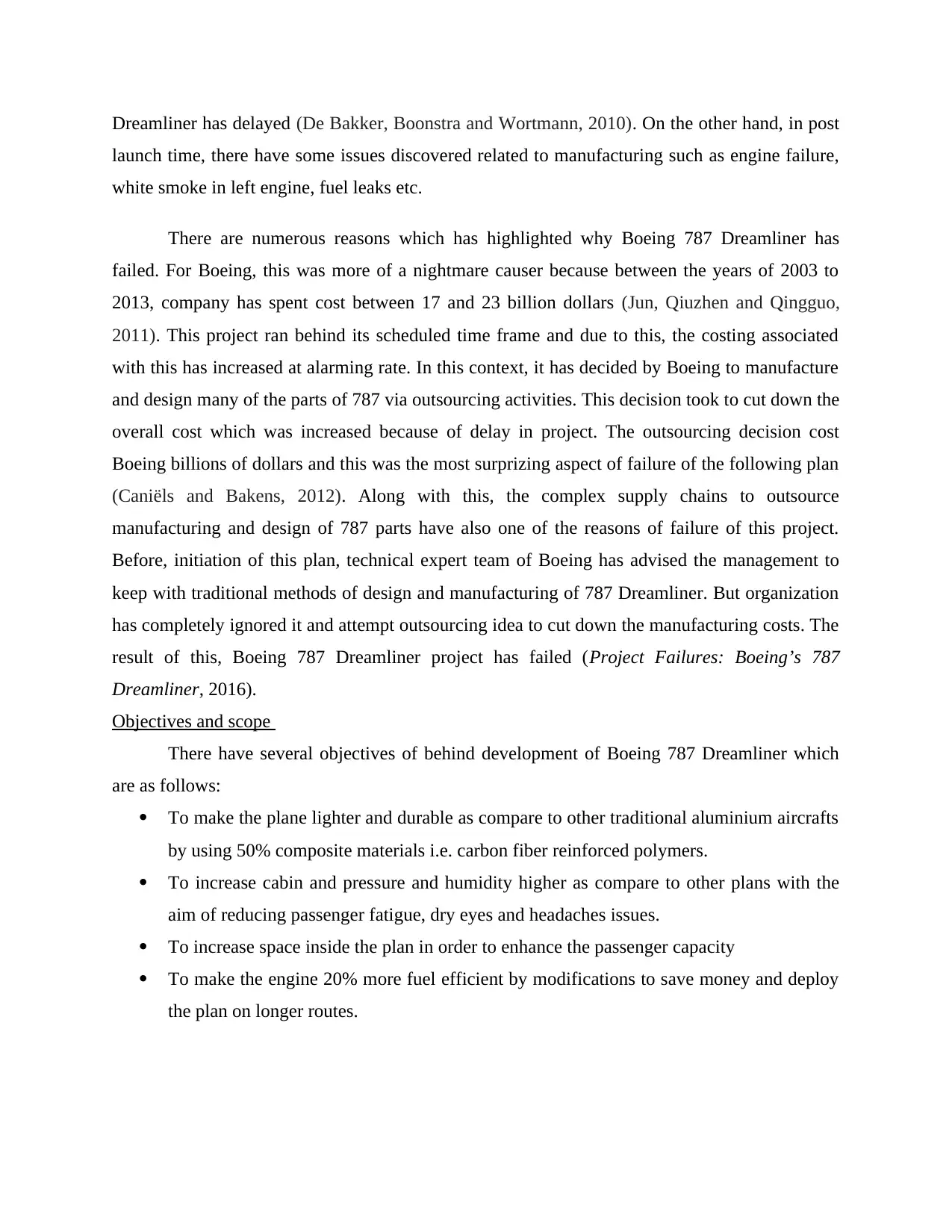
Dreamliner has delayed (De Bakker, Boonstra and Wortmann, 2010). On the other hand, in post
launch time, there have some issues discovered related to manufacturing such as engine failure,
white smoke in left engine, fuel leaks etc.
There are numerous reasons which has highlighted why Boeing 787 Dreamliner has
failed. For Boeing, this was more of a nightmare causer because between the years of 2003 to
2013, company has spent cost between 17 and 23 billion dollars (Jun, Qiuzhen and Qingguo,
2011). This project ran behind its scheduled time frame and due to this, the costing associated
with this has increased at alarming rate. In this context, it has decided by Boeing to manufacture
and design many of the parts of 787 via outsourcing activities. This decision took to cut down the
overall cost which was increased because of delay in project. The outsourcing decision cost
Boeing billions of dollars and this was the most surprizing aspect of failure of the following plan
(Caniëls and Bakens, 2012). Along with this, the complex supply chains to outsource
manufacturing and design of 787 parts have also one of the reasons of failure of this project.
Before, initiation of this plan, technical expert team of Boeing has advised the management to
keep with traditional methods of design and manufacturing of 787 Dreamliner. But organization
has completely ignored it and attempt outsourcing idea to cut down the manufacturing costs. The
result of this, Boeing 787 Dreamliner project has failed (Project Failures: Boeing’s 787
Dreamliner, 2016).
Objectives and scope
There have several objectives of behind development of Boeing 787 Dreamliner which
are as follows:
To make the plane lighter and durable as compare to other traditional aluminium aircrafts
by using 50% composite materials i.e. carbon fiber reinforced polymers.
To increase cabin and pressure and humidity higher as compare to other plans with the
aim of reducing passenger fatigue, dry eyes and headaches issues.
To increase space inside the plan in order to enhance the passenger capacity
To make the engine 20% more fuel efficient by modifications to save money and deploy
the plan on longer routes.
launch time, there have some issues discovered related to manufacturing such as engine failure,
white smoke in left engine, fuel leaks etc.
There are numerous reasons which has highlighted why Boeing 787 Dreamliner has
failed. For Boeing, this was more of a nightmare causer because between the years of 2003 to
2013, company has spent cost between 17 and 23 billion dollars (Jun, Qiuzhen and Qingguo,
2011). This project ran behind its scheduled time frame and due to this, the costing associated
with this has increased at alarming rate. In this context, it has decided by Boeing to manufacture
and design many of the parts of 787 via outsourcing activities. This decision took to cut down the
overall cost which was increased because of delay in project. The outsourcing decision cost
Boeing billions of dollars and this was the most surprizing aspect of failure of the following plan
(Caniëls and Bakens, 2012). Along with this, the complex supply chains to outsource
manufacturing and design of 787 parts have also one of the reasons of failure of this project.
Before, initiation of this plan, technical expert team of Boeing has advised the management to
keep with traditional methods of design and manufacturing of 787 Dreamliner. But organization
has completely ignored it and attempt outsourcing idea to cut down the manufacturing costs. The
result of this, Boeing 787 Dreamliner project has failed (Project Failures: Boeing’s 787
Dreamliner, 2016).
Objectives and scope
There have several objectives of behind development of Boeing 787 Dreamliner which
are as follows:
To make the plane lighter and durable as compare to other traditional aluminium aircrafts
by using 50% composite materials i.e. carbon fiber reinforced polymers.
To increase cabin and pressure and humidity higher as compare to other plans with the
aim of reducing passenger fatigue, dry eyes and headaches issues.
To increase space inside the plan in order to enhance the passenger capacity
To make the engine 20% more fuel efficient by modifications to save money and deploy
the plan on longer routes.
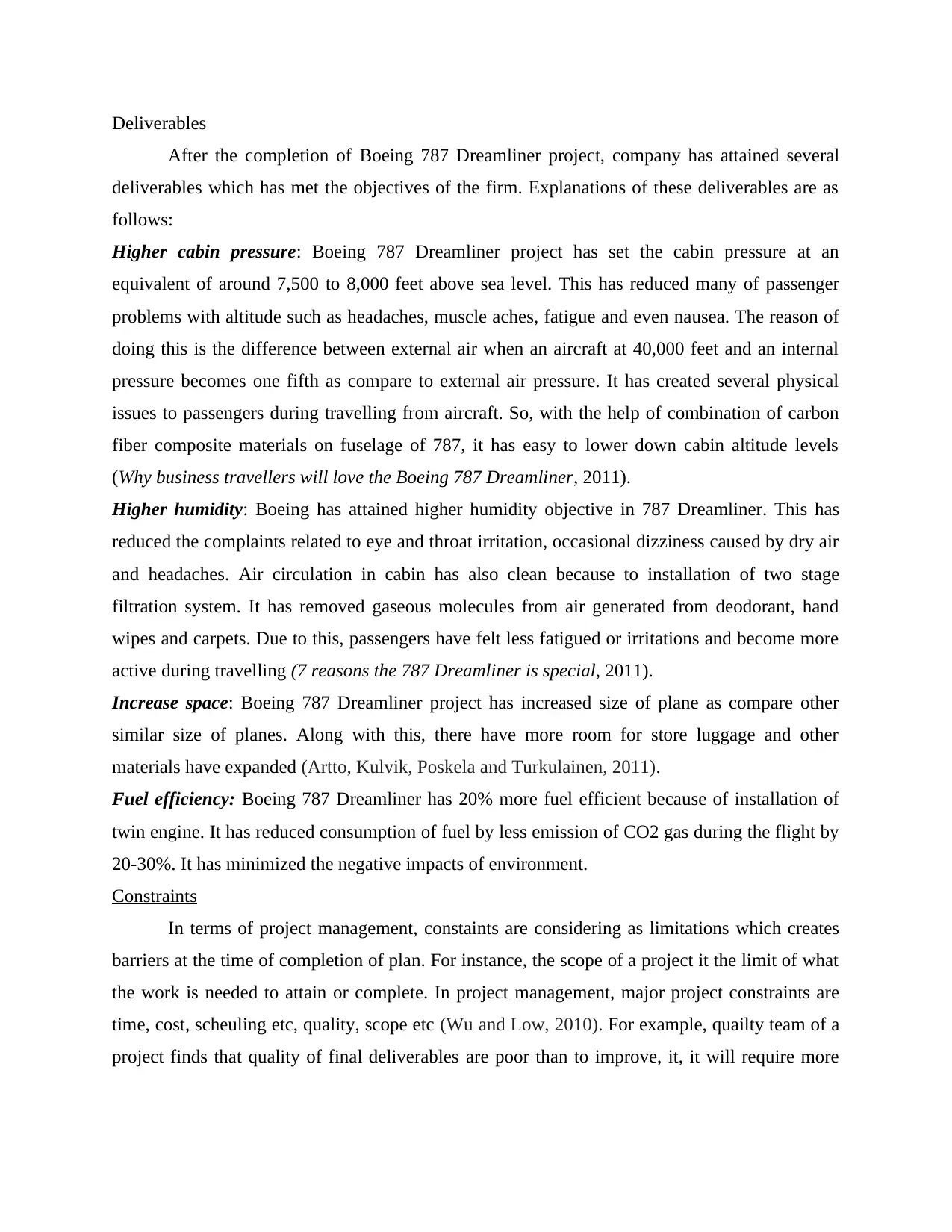
Deliverables
After the completion of Boeing 787 Dreamliner project, company has attained several
deliverables which has met the objectives of the firm. Explanations of these deliverables are as
follows:
Higher cabin pressure: Boeing 787 Dreamliner project has set the cabin pressure at an
equivalent of around 7,500 to 8,000 feet above sea level. This has reduced many of passenger
problems with altitude such as headaches, muscle aches, fatigue and even nausea. The reason of
doing this is the difference between external air when an aircraft at 40,000 feet and an internal
pressure becomes one fifth as compare to external air pressure. It has created several physical
issues to passengers during travelling from aircraft. So, with the help of combination of carbon
fiber composite materials on fuselage of 787, it has easy to lower down cabin altitude levels
(Why business travellers will love the Boeing 787 Dreamliner, 2011).
Higher humidity: Boeing has attained higher humidity objective in 787 Dreamliner. This has
reduced the complaints related to eye and throat irritation, occasional dizziness caused by dry air
and headaches. Air circulation in cabin has also clean because to installation of two stage
filtration system. It has removed gaseous molecules from air generated from deodorant, hand
wipes and carpets. Due to this, passengers have felt less fatigued or irritations and become more
active during travelling (7 reasons the 787 Dreamliner is special, 2011).
Increase space: Boeing 787 Dreamliner project has increased size of plane as compare other
similar size of planes. Along with this, there have more room for store luggage and other
materials have expanded (Artto, Kulvik, Poskela and Turkulainen, 2011).
Fuel efficiency: Boeing 787 Dreamliner has 20% more fuel efficient because of installation of
twin engine. It has reduced consumption of fuel by less emission of CO2 gas during the flight by
20-30%. It has minimized the negative impacts of environment.
Constraints
In terms of project management, constaints are considering as limitations which creates
barriers at the time of completion of plan. For instance, the scope of a project it the limit of what
the work is needed to attain or complete. In project management, major project constraints are
time, cost, scheuling etc, quality, scope etc (Wu and Low, 2010). For example, quailty team of a
project finds that quality of final deliverables are poor than to improve, it, it will require more
After the completion of Boeing 787 Dreamliner project, company has attained several
deliverables which has met the objectives of the firm. Explanations of these deliverables are as
follows:
Higher cabin pressure: Boeing 787 Dreamliner project has set the cabin pressure at an
equivalent of around 7,500 to 8,000 feet above sea level. This has reduced many of passenger
problems with altitude such as headaches, muscle aches, fatigue and even nausea. The reason of
doing this is the difference between external air when an aircraft at 40,000 feet and an internal
pressure becomes one fifth as compare to external air pressure. It has created several physical
issues to passengers during travelling from aircraft. So, with the help of combination of carbon
fiber composite materials on fuselage of 787, it has easy to lower down cabin altitude levels
(Why business travellers will love the Boeing 787 Dreamliner, 2011).
Higher humidity: Boeing has attained higher humidity objective in 787 Dreamliner. This has
reduced the complaints related to eye and throat irritation, occasional dizziness caused by dry air
and headaches. Air circulation in cabin has also clean because to installation of two stage
filtration system. It has removed gaseous molecules from air generated from deodorant, hand
wipes and carpets. Due to this, passengers have felt less fatigued or irritations and become more
active during travelling (7 reasons the 787 Dreamliner is special, 2011).
Increase space: Boeing 787 Dreamliner project has increased size of plane as compare other
similar size of planes. Along with this, there have more room for store luggage and other
materials have expanded (Artto, Kulvik, Poskela and Turkulainen, 2011).
Fuel efficiency: Boeing 787 Dreamliner has 20% more fuel efficient because of installation of
twin engine. It has reduced consumption of fuel by less emission of CO2 gas during the flight by
20-30%. It has minimized the negative impacts of environment.
Constraints
In terms of project management, constaints are considering as limitations which creates
barriers at the time of completion of plan. For instance, the scope of a project it the limit of what
the work is needed to attain or complete. In project management, major project constraints are
time, cost, scheuling etc, quality, scope etc (Wu and Low, 2010). For example, quailty team of a
project finds that quality of final deliverables are poor than to improve, it, it will require more
⊘ This is a preview!⊘
Do you want full access?
Subscribe today to unlock all pages.

Trusted by 1+ million students worldwide
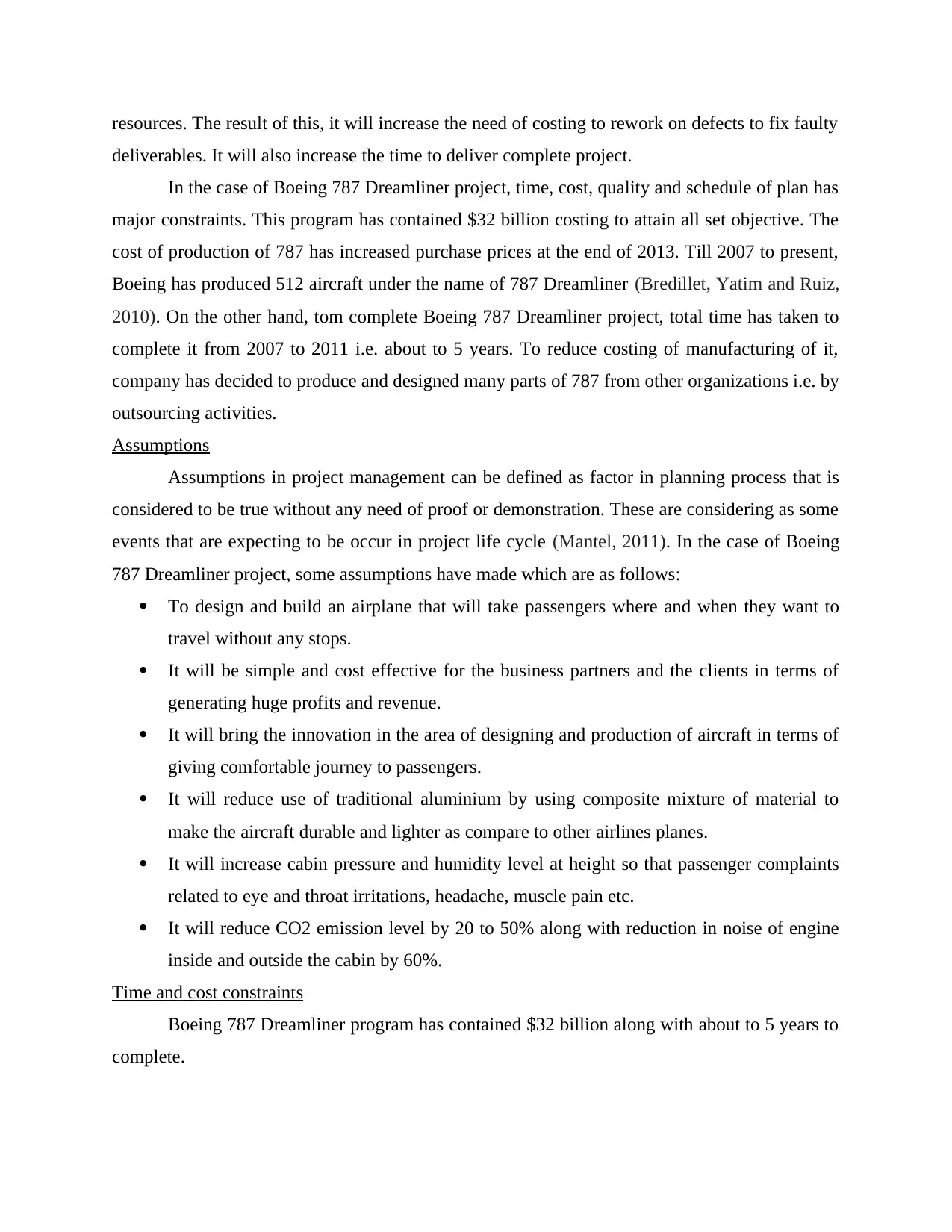
resources. The result of this, it will increase the need of costing to rework on defects to fix faulty
deliverables. It will also increase the time to deliver complete project.
In the case of Boeing 787 Dreamliner project, time, cost, quality and schedule of plan has
major constraints. This program has contained $32 billion costing to attain all set objective. The
cost of production of 787 has increased purchase prices at the end of 2013. Till 2007 to present,
Boeing has produced 512 aircraft under the name of 787 Dreamliner (Bredillet, Yatim and Ruiz,
2010). On the other hand, tom complete Boeing 787 Dreamliner project, total time has taken to
complete it from 2007 to 2011 i.e. about to 5 years. To reduce costing of manufacturing of it,
company has decided to produce and designed many parts of 787 from other organizations i.e. by
outsourcing activities.
Assumptions
Assumptions in project management can be defined as factor in planning process that is
considered to be true without any need of proof or demonstration. These are considering as some
events that are expecting to be occur in project life cycle (Mantel, 2011). In the case of Boeing
787 Dreamliner project, some assumptions have made which are as follows:
To design and build an airplane that will take passengers where and when they want to
travel without any stops.
It will be simple and cost effective for the business partners and the clients in terms of
generating huge profits and revenue.
It will bring the innovation in the area of designing and production of aircraft in terms of
giving comfortable journey to passengers.
It will reduce use of traditional aluminium by using composite mixture of material to
make the aircraft durable and lighter as compare to other airlines planes.
It will increase cabin pressure and humidity level at height so that passenger complaints
related to eye and throat irritations, headache, muscle pain etc.
It will reduce CO2 emission level by 20 to 50% along with reduction in noise of engine
inside and outside the cabin by 60%.
Time and cost constraints
Boeing 787 Dreamliner program has contained $32 billion along with about to 5 years to
complete.
deliverables. It will also increase the time to deliver complete project.
In the case of Boeing 787 Dreamliner project, time, cost, quality and schedule of plan has
major constraints. This program has contained $32 billion costing to attain all set objective. The
cost of production of 787 has increased purchase prices at the end of 2013. Till 2007 to present,
Boeing has produced 512 aircraft under the name of 787 Dreamliner (Bredillet, Yatim and Ruiz,
2010). On the other hand, tom complete Boeing 787 Dreamliner project, total time has taken to
complete it from 2007 to 2011 i.e. about to 5 years. To reduce costing of manufacturing of it,
company has decided to produce and designed many parts of 787 from other organizations i.e. by
outsourcing activities.
Assumptions
Assumptions in project management can be defined as factor in planning process that is
considered to be true without any need of proof or demonstration. These are considering as some
events that are expecting to be occur in project life cycle (Mantel, 2011). In the case of Boeing
787 Dreamliner project, some assumptions have made which are as follows:
To design and build an airplane that will take passengers where and when they want to
travel without any stops.
It will be simple and cost effective for the business partners and the clients in terms of
generating huge profits and revenue.
It will bring the innovation in the area of designing and production of aircraft in terms of
giving comfortable journey to passengers.
It will reduce use of traditional aluminium by using composite mixture of material to
make the aircraft durable and lighter as compare to other airlines planes.
It will increase cabin pressure and humidity level at height so that passenger complaints
related to eye and throat irritations, headache, muscle pain etc.
It will reduce CO2 emission level by 20 to 50% along with reduction in noise of engine
inside and outside the cabin by 60%.
Time and cost constraints
Boeing 787 Dreamliner program has contained $32 billion along with about to 5 years to
complete.
Paraphrase This Document
Need a fresh take? Get an instant paraphrase of this document with our AI Paraphraser
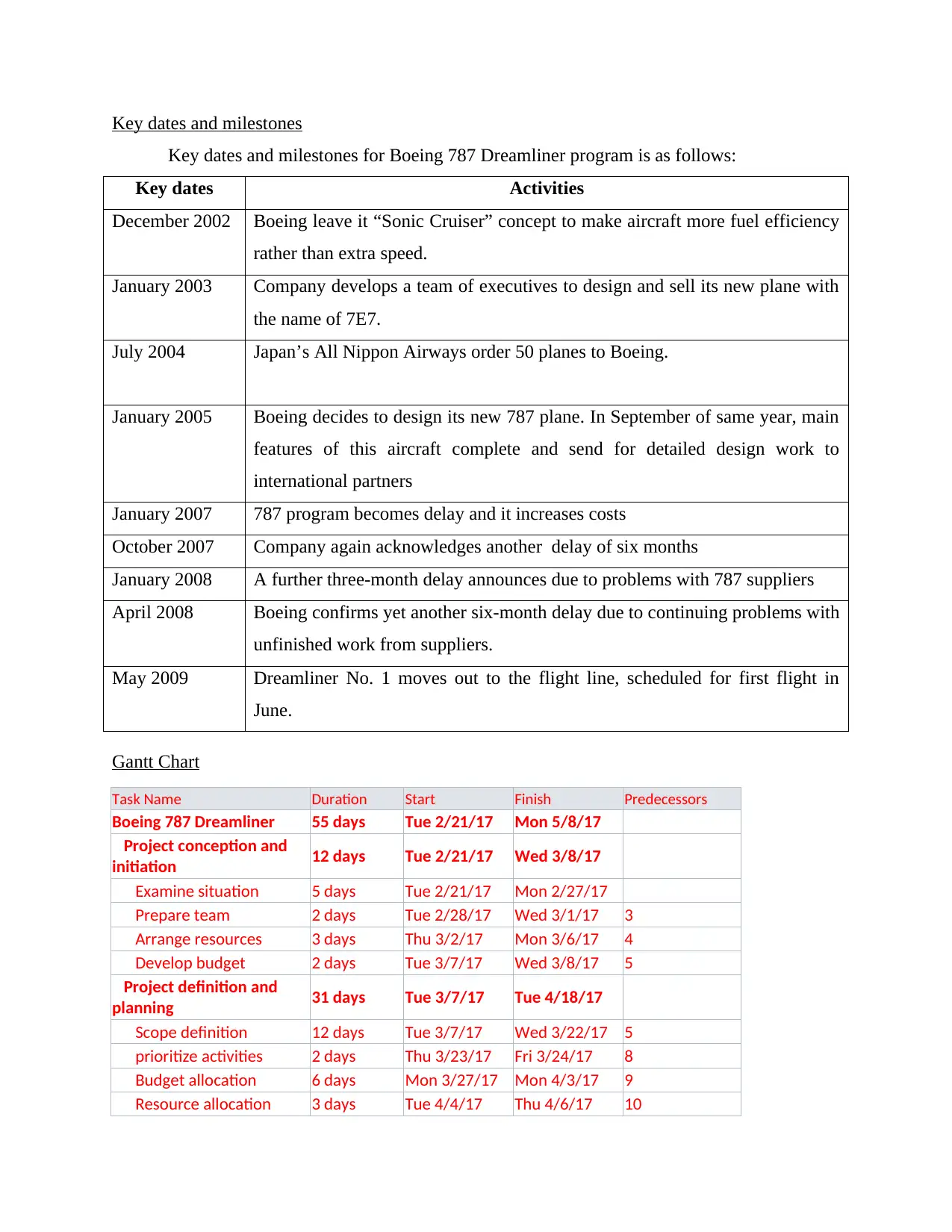
Key dates and milestones
Key dates and milestones for Boeing 787 Dreamliner program is as follows:
Key dates Activities
December 2002 Boeing leave it “Sonic Cruiser” concept to make aircraft more fuel efficiency
rather than extra speed.
January 2003 Company develops a team of executives to design and sell its new plane with
the name of 7E7.
July 2004 Japan’s All Nippon Airways order 50 planes to Boeing.
January 2005 Boeing decides to design its new 787 plane. In September of same year, main
features of this aircraft complete and send for detailed design work to
international partners
January 2007 787 program becomes delay and it increases costs
October 2007 Company again acknowledges another delay of six months
January 2008 A further three-month delay announces due to problems with 787 suppliers
April 2008 Boeing confirms yet another six-month delay due to continuing problems with
unfinished work from suppliers.
May 2009 Dreamliner No. 1 moves out to the flight line, scheduled for first flight in
June.
Gantt Chart
Task Name Duration Start Finish Predecessors
Boeing 787 Dreamliner 55 days Tue 2/21/17 Mon 5/8/17
Project conception and
initiation 12 days Tue 2/21/17 Wed 3/8/17
Examine situation 5 days Tue 2/21/17 Mon 2/27/17
Prepare team 2 days Tue 2/28/17 Wed 3/1/17 3
Arrange resources 3 days Thu 3/2/17 Mon 3/6/17 4
Develop budget 2 days Tue 3/7/17 Wed 3/8/17 5
Project definition and
planning 31 days Tue 3/7/17 Tue 4/18/17
Scope definition 12 days Tue 3/7/17 Wed 3/22/17 5
prioritize activities 2 days Thu 3/23/17 Fri 3/24/17 8
Budget allocation 6 days Mon 3/27/17 Mon 4/3/17 9
Resource allocation 3 days Tue 4/4/17 Thu 4/6/17 10
Key dates and milestones for Boeing 787 Dreamliner program is as follows:
Key dates Activities
December 2002 Boeing leave it “Sonic Cruiser” concept to make aircraft more fuel efficiency
rather than extra speed.
January 2003 Company develops a team of executives to design and sell its new plane with
the name of 7E7.
July 2004 Japan’s All Nippon Airways order 50 planes to Boeing.
January 2005 Boeing decides to design its new 787 plane. In September of same year, main
features of this aircraft complete and send for detailed design work to
international partners
January 2007 787 program becomes delay and it increases costs
October 2007 Company again acknowledges another delay of six months
January 2008 A further three-month delay announces due to problems with 787 suppliers
April 2008 Boeing confirms yet another six-month delay due to continuing problems with
unfinished work from suppliers.
May 2009 Dreamliner No. 1 moves out to the flight line, scheduled for first flight in
June.
Gantt Chart
Task Name Duration Start Finish Predecessors
Boeing 787 Dreamliner 55 days Tue 2/21/17 Mon 5/8/17
Project conception and
initiation 12 days Tue 2/21/17 Wed 3/8/17
Examine situation 5 days Tue 2/21/17 Mon 2/27/17
Prepare team 2 days Tue 2/28/17 Wed 3/1/17 3
Arrange resources 3 days Thu 3/2/17 Mon 3/6/17 4
Develop budget 2 days Tue 3/7/17 Wed 3/8/17 5
Project definition and
planning 31 days Tue 3/7/17 Tue 4/18/17
Scope definition 12 days Tue 3/7/17 Wed 3/22/17 5
prioritize activities 2 days Thu 3/23/17 Fri 3/24/17 8
Budget allocation 6 days Mon 3/27/17 Mon 4/3/17 9
Resource allocation 3 days Tue 4/4/17 Thu 4/6/17 10
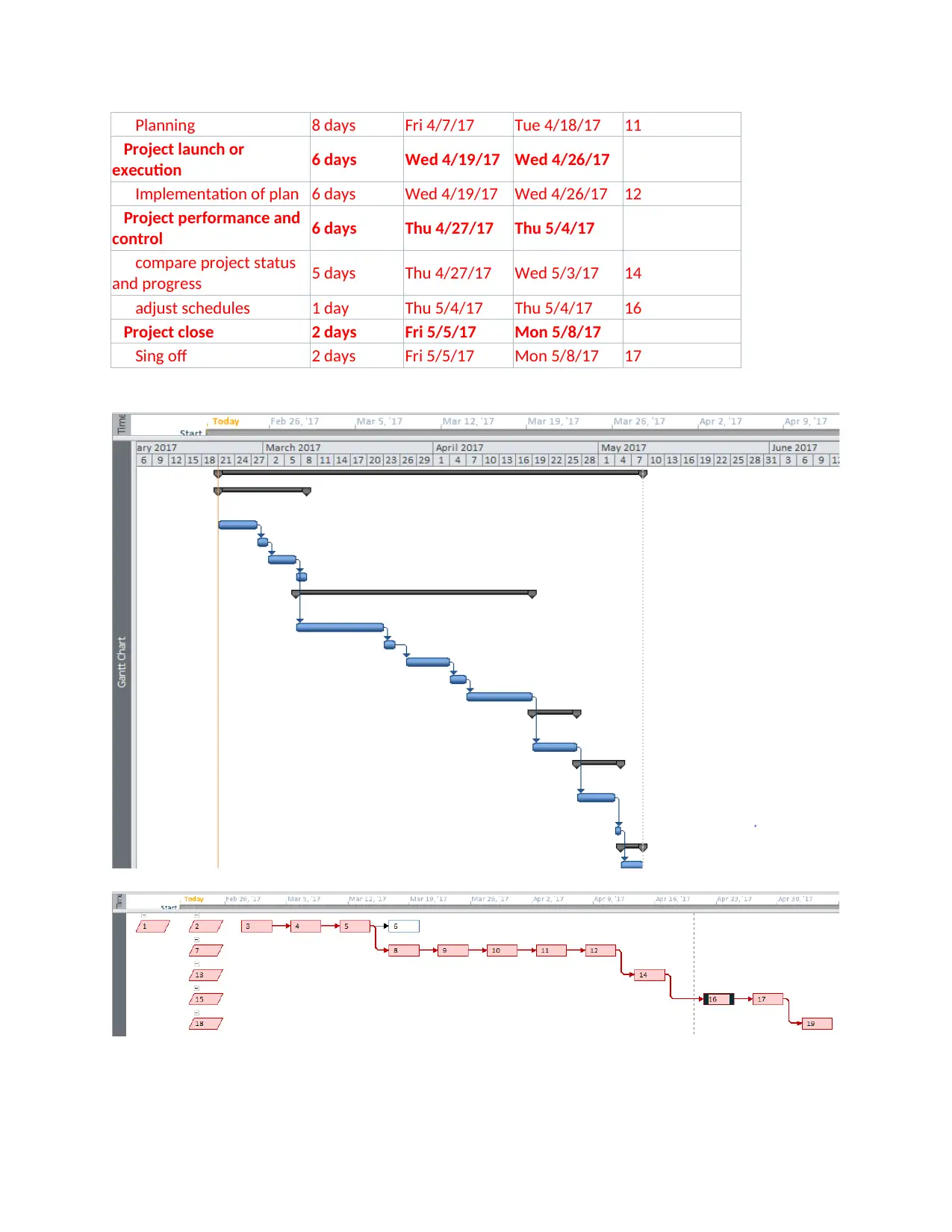
Planning 8 days Fri 4/7/17 Tue 4/18/17 11
Project launch or
execution 6 days Wed 4/19/17 Wed 4/26/17
Implementation of plan 6 days Wed 4/19/17 Wed 4/26/17 12
Project performance and
control 6 days Thu 4/27/17 Thu 5/4/17
compare project status
and progress 5 days Thu 4/27/17 Wed 5/3/17 14
adjust schedules 1 day Thu 5/4/17 Thu 5/4/17 16
Project close 2 days Fri 5/5/17 Mon 5/8/17
Sing off 2 days Fri 5/5/17 Mon 5/8/17 17
Project launch or
execution 6 days Wed 4/19/17 Wed 4/26/17
Implementation of plan 6 days Wed 4/19/17 Wed 4/26/17 12
Project performance and
control 6 days Thu 4/27/17 Thu 5/4/17
compare project status
and progress 5 days Thu 4/27/17 Wed 5/3/17 14
adjust schedules 1 day Thu 5/4/17 Thu 5/4/17 16
Project close 2 days Fri 5/5/17 Mon 5/8/17
Sing off 2 days Fri 5/5/17 Mon 5/8/17 17
⊘ This is a preview!⊘
Do you want full access?
Subscribe today to unlock all pages.

Trusted by 1+ million students worldwide
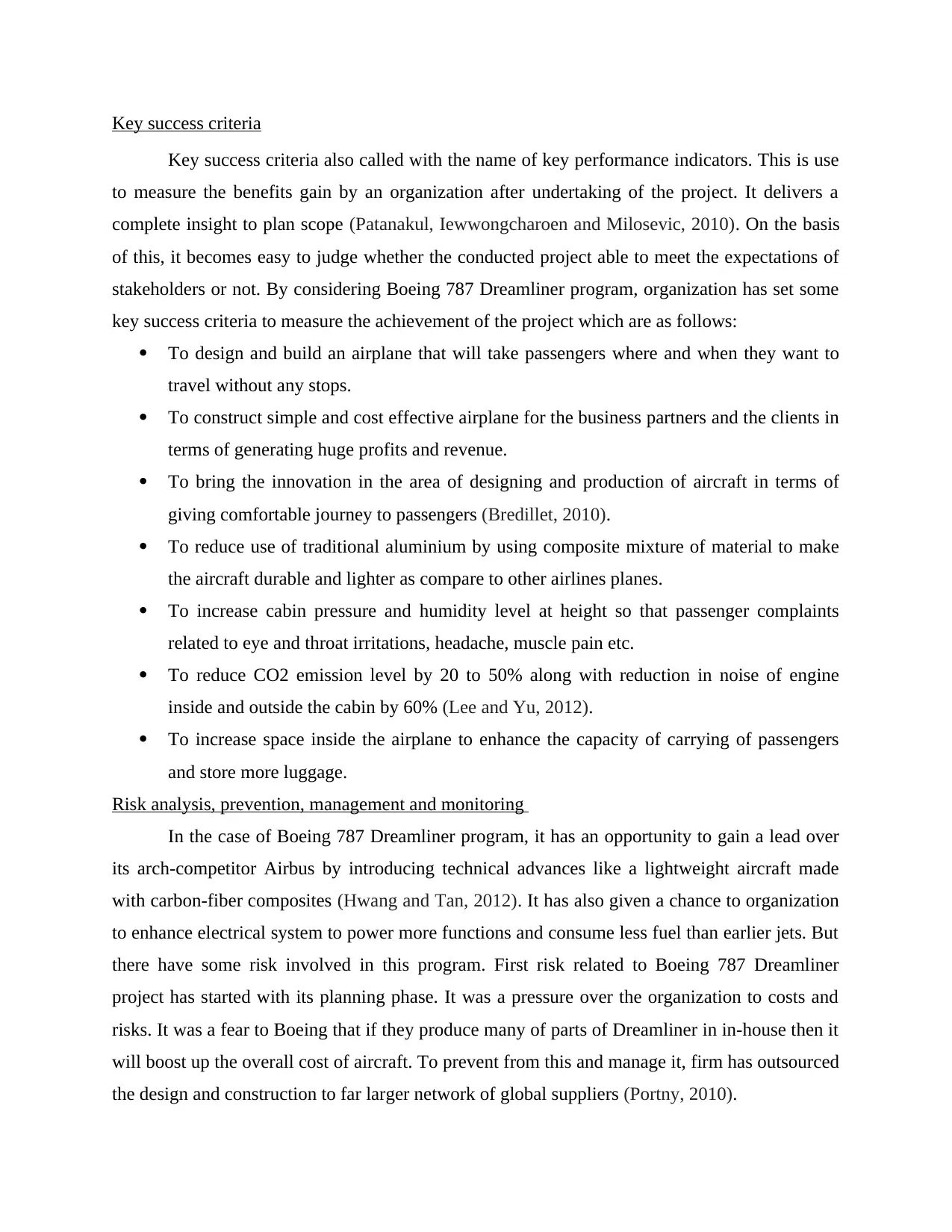
Key success criteria
Key success criteria also called with the name of key performance indicators. This is use
to measure the benefits gain by an organization after undertaking of the project. It delivers a
complete insight to plan scope (Patanakul, Iewwongcharoen and Milosevic, 2010). On the basis
of this, it becomes easy to judge whether the conducted project able to meet the expectations of
stakeholders or not. By considering Boeing 787 Dreamliner program, organization has set some
key success criteria to measure the achievement of the project which are as follows:
To design and build an airplane that will take passengers where and when they want to
travel without any stops.
To construct simple and cost effective airplane for the business partners and the clients in
terms of generating huge profits and revenue.
To bring the innovation in the area of designing and production of aircraft in terms of
giving comfortable journey to passengers (Bredillet, 2010).
To reduce use of traditional aluminium by using composite mixture of material to make
the aircraft durable and lighter as compare to other airlines planes.
To increase cabin pressure and humidity level at height so that passenger complaints
related to eye and throat irritations, headache, muscle pain etc.
To reduce CO2 emission level by 20 to 50% along with reduction in noise of engine
inside and outside the cabin by 60% (Lee and Yu, 2012).
To increase space inside the airplane to enhance the capacity of carrying of passengers
and store more luggage.
Risk analysis, prevention, management and monitoring
In the case of Boeing 787 Dreamliner program, it has an opportunity to gain a lead over
its arch-competitor Airbus by introducing technical advances like a lightweight aircraft made
with carbon-fiber composites (Hwang and Tan, 2012). It has also given a chance to organization
to enhance electrical system to power more functions and consume less fuel than earlier jets. But
there have some risk involved in this program. First risk related to Boeing 787 Dreamliner
project has started with its planning phase. It was a pressure over the organization to costs and
risks. It was a fear to Boeing that if they produce many of parts of Dreamliner in in-house then it
will boost up the overall cost of aircraft. To prevent from this and manage it, firm has outsourced
the design and construction to far larger network of global suppliers (Portny, 2010).
Key success criteria also called with the name of key performance indicators. This is use
to measure the benefits gain by an organization after undertaking of the project. It delivers a
complete insight to plan scope (Patanakul, Iewwongcharoen and Milosevic, 2010). On the basis
of this, it becomes easy to judge whether the conducted project able to meet the expectations of
stakeholders or not. By considering Boeing 787 Dreamliner program, organization has set some
key success criteria to measure the achievement of the project which are as follows:
To design and build an airplane that will take passengers where and when they want to
travel without any stops.
To construct simple and cost effective airplane for the business partners and the clients in
terms of generating huge profits and revenue.
To bring the innovation in the area of designing and production of aircraft in terms of
giving comfortable journey to passengers (Bredillet, 2010).
To reduce use of traditional aluminium by using composite mixture of material to make
the aircraft durable and lighter as compare to other airlines planes.
To increase cabin pressure and humidity level at height so that passenger complaints
related to eye and throat irritations, headache, muscle pain etc.
To reduce CO2 emission level by 20 to 50% along with reduction in noise of engine
inside and outside the cabin by 60% (Lee and Yu, 2012).
To increase space inside the airplane to enhance the capacity of carrying of passengers
and store more luggage.
Risk analysis, prevention, management and monitoring
In the case of Boeing 787 Dreamliner program, it has an opportunity to gain a lead over
its arch-competitor Airbus by introducing technical advances like a lightweight aircraft made
with carbon-fiber composites (Hwang and Tan, 2012). It has also given a chance to organization
to enhance electrical system to power more functions and consume less fuel than earlier jets. But
there have some risk involved in this program. First risk related to Boeing 787 Dreamliner
project has started with its planning phase. It was a pressure over the organization to costs and
risks. It was a fear to Boeing that if they produce many of parts of Dreamliner in in-house then it
will boost up the overall cost of aircraft. To prevent from this and manage it, firm has outsourced
the design and construction to far larger network of global suppliers (Portny, 2010).
Paraphrase This Document
Need a fresh take? Get an instant paraphrase of this document with our AI Paraphraser
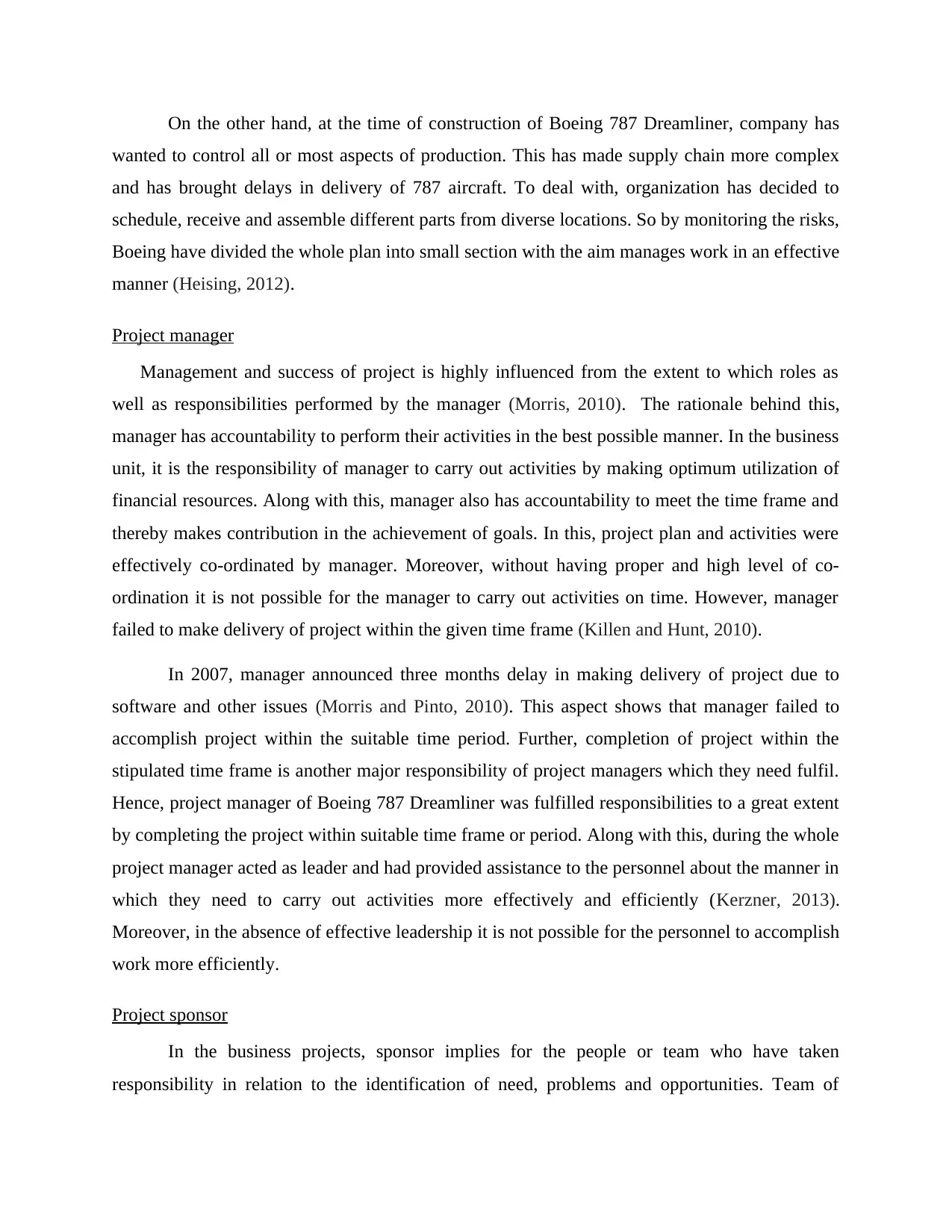
On the other hand, at the time of construction of Boeing 787 Dreamliner, company has
wanted to control all or most aspects of production. This has made supply chain more complex
and has brought delays in delivery of 787 aircraft. To deal with, organization has decided to
schedule, receive and assemble different parts from diverse locations. So by monitoring the risks,
Boeing have divided the whole plan into small section with the aim manages work in an effective
manner (Heising, 2012).
Project manager
Management and success of project is highly influenced from the extent to which roles as
well as responsibilities performed by the manager (Morris, 2010). The rationale behind this,
manager has accountability to perform their activities in the best possible manner. In the business
unit, it is the responsibility of manager to carry out activities by making optimum utilization of
financial resources. Along with this, manager also has accountability to meet the time frame and
thereby makes contribution in the achievement of goals. In this, project plan and activities were
effectively co-ordinated by manager. Moreover, without having proper and high level of co-
ordination it is not possible for the manager to carry out activities on time. However, manager
failed to make delivery of project within the given time frame (Killen and Hunt, 2010).
In 2007, manager announced three months delay in making delivery of project due to
software and other issues (Morris and Pinto, 2010). This aspect shows that manager failed to
accomplish project within the suitable time period. Further, completion of project within the
stipulated time frame is another major responsibility of project managers which they need fulfil.
Hence, project manager of Boeing 787 Dreamliner was fulfilled responsibilities to a great extent
by completing the project within suitable time frame or period. Along with this, during the whole
project manager acted as leader and had provided assistance to the personnel about the manner in
which they need to carry out activities more effectively and efficiently (Kerzner, 2013).
Moreover, in the absence of effective leadership it is not possible for the personnel to accomplish
work more efficiently.
Project sponsor
In the business projects, sponsor implies for the people or team who have taken
responsibility in relation to the identification of need, problems and opportunities. Team of
wanted to control all or most aspects of production. This has made supply chain more complex
and has brought delays in delivery of 787 aircraft. To deal with, organization has decided to
schedule, receive and assemble different parts from diverse locations. So by monitoring the risks,
Boeing have divided the whole plan into small section with the aim manages work in an effective
manner (Heising, 2012).
Project manager
Management and success of project is highly influenced from the extent to which roles as
well as responsibilities performed by the manager (Morris, 2010). The rationale behind this,
manager has accountability to perform their activities in the best possible manner. In the business
unit, it is the responsibility of manager to carry out activities by making optimum utilization of
financial resources. Along with this, manager also has accountability to meet the time frame and
thereby makes contribution in the achievement of goals. In this, project plan and activities were
effectively co-ordinated by manager. Moreover, without having proper and high level of co-
ordination it is not possible for the manager to carry out activities on time. However, manager
failed to make delivery of project within the given time frame (Killen and Hunt, 2010).
In 2007, manager announced three months delay in making delivery of project due to
software and other issues (Morris and Pinto, 2010). This aspect shows that manager failed to
accomplish project within the suitable time period. Further, completion of project within the
stipulated time frame is another major responsibility of project managers which they need fulfil.
Hence, project manager of Boeing 787 Dreamliner was fulfilled responsibilities to a great extent
by completing the project within suitable time frame or period. Along with this, during the whole
project manager acted as leader and had provided assistance to the personnel about the manner in
which they need to carry out activities more effectively and efficiently (Kerzner, 2013).
Moreover, in the absence of effective leadership it is not possible for the personnel to accomplish
work more efficiently.
Project sponsor
In the business projects, sponsor implies for the people or team who have taken
responsibility in relation to the identification of need, problems and opportunities. Team of
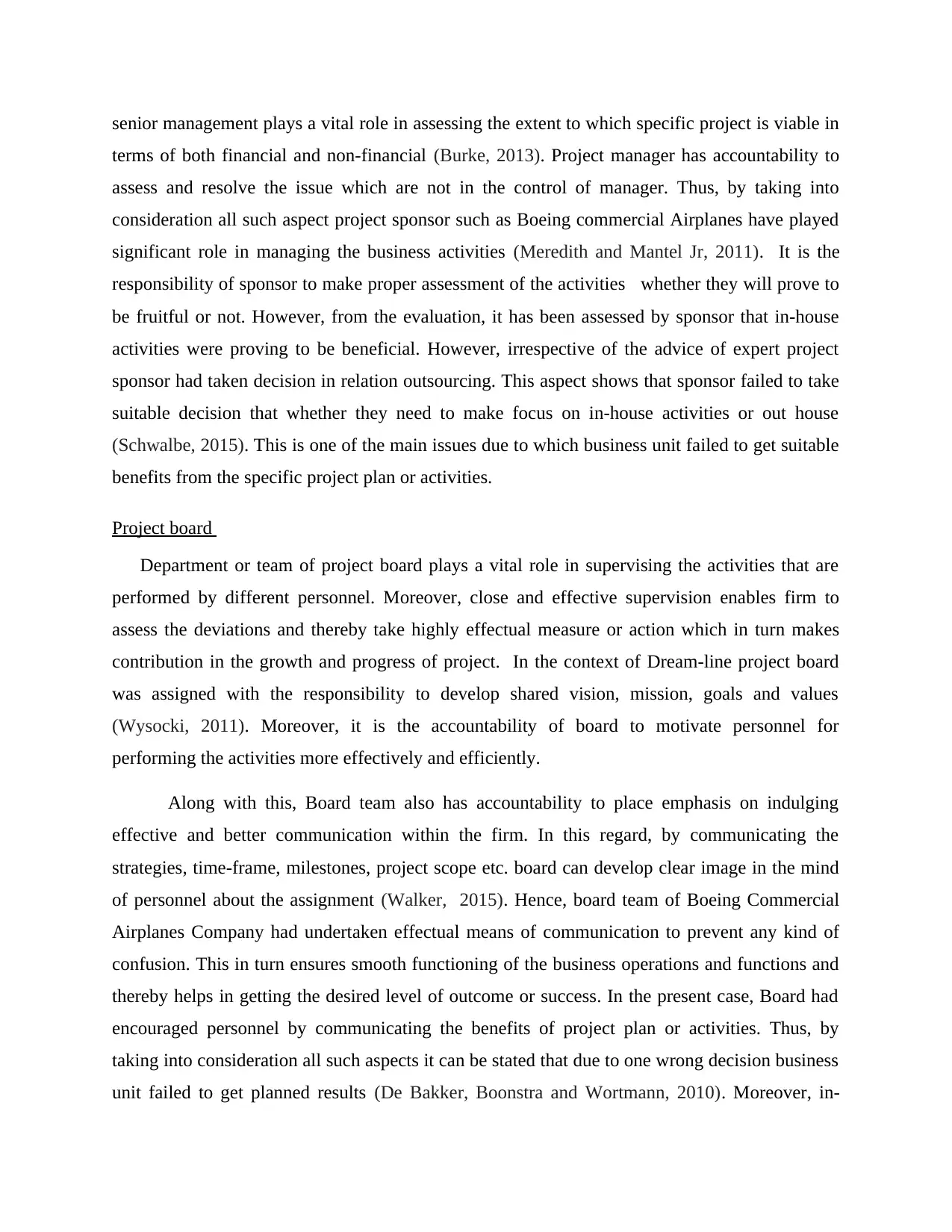
senior management plays a vital role in assessing the extent to which specific project is viable in
terms of both financial and non-financial (Burke, 2013). Project manager has accountability to
assess and resolve the issue which are not in the control of manager. Thus, by taking into
consideration all such aspect project sponsor such as Boeing commercial Airplanes have played
significant role in managing the business activities (Meredith and Mantel Jr, 2011). It is the
responsibility of sponsor to make proper assessment of the activities whether they will prove to
be fruitful or not. However, from the evaluation, it has been assessed by sponsor that in-house
activities were proving to be beneficial. However, irrespective of the advice of expert project
sponsor had taken decision in relation outsourcing. This aspect shows that sponsor failed to take
suitable decision that whether they need to make focus on in-house activities or out house
(Schwalbe, 2015). This is one of the main issues due to which business unit failed to get suitable
benefits from the specific project plan or activities.
Project board
Department or team of project board plays a vital role in supervising the activities that are
performed by different personnel. Moreover, close and effective supervision enables firm to
assess the deviations and thereby take highly effectual measure or action which in turn makes
contribution in the growth and progress of project. In the context of Dream-line project board
was assigned with the responsibility to develop shared vision, mission, goals and values
(Wysocki, 2011). Moreover, it is the accountability of board to motivate personnel for
performing the activities more effectively and efficiently.
Along with this, Board team also has accountability to place emphasis on indulging
effective and better communication within the firm. In this regard, by communicating the
strategies, time-frame, milestones, project scope etc. board can develop clear image in the mind
of personnel about the assignment (Walker, 2015). Hence, board team of Boeing Commercial
Airplanes Company had undertaken effectual means of communication to prevent any kind of
confusion. This in turn ensures smooth functioning of the business operations and functions and
thereby helps in getting the desired level of outcome or success. In the present case, Board had
encouraged personnel by communicating the benefits of project plan or activities. Thus, by
taking into consideration all such aspects it can be stated that due to one wrong decision business
unit failed to get planned results (De Bakker, Boonstra and Wortmann, 2010). Moreover, in-
terms of both financial and non-financial (Burke, 2013). Project manager has accountability to
assess and resolve the issue which are not in the control of manager. Thus, by taking into
consideration all such aspect project sponsor such as Boeing commercial Airplanes have played
significant role in managing the business activities (Meredith and Mantel Jr, 2011). It is the
responsibility of sponsor to make proper assessment of the activities whether they will prove to
be fruitful or not. However, from the evaluation, it has been assessed by sponsor that in-house
activities were proving to be beneficial. However, irrespective of the advice of expert project
sponsor had taken decision in relation outsourcing. This aspect shows that sponsor failed to take
suitable decision that whether they need to make focus on in-house activities or out house
(Schwalbe, 2015). This is one of the main issues due to which business unit failed to get suitable
benefits from the specific project plan or activities.
Project board
Department or team of project board plays a vital role in supervising the activities that are
performed by different personnel. Moreover, close and effective supervision enables firm to
assess the deviations and thereby take highly effectual measure or action which in turn makes
contribution in the growth and progress of project. In the context of Dream-line project board
was assigned with the responsibility to develop shared vision, mission, goals and values
(Wysocki, 2011). Moreover, it is the accountability of board to motivate personnel for
performing the activities more effectively and efficiently.
Along with this, Board team also has accountability to place emphasis on indulging
effective and better communication within the firm. In this regard, by communicating the
strategies, time-frame, milestones, project scope etc. board can develop clear image in the mind
of personnel about the assignment (Walker, 2015). Hence, board team of Boeing Commercial
Airplanes Company had undertaken effectual means of communication to prevent any kind of
confusion. This in turn ensures smooth functioning of the business operations and functions and
thereby helps in getting the desired level of outcome or success. In the present case, Board had
encouraged personnel by communicating the benefits of project plan or activities. Thus, by
taking into consideration all such aspects it can be stated that due to one wrong decision business
unit failed to get planned results (De Bakker, Boonstra and Wortmann, 2010). Moreover, in-
⊘ This is a preview!⊘
Do you want full access?
Subscribe today to unlock all pages.

Trusted by 1+ million students worldwide
1 out of 16
Related Documents
Your All-in-One AI-Powered Toolkit for Academic Success.
+13062052269
info@desklib.com
Available 24*7 on WhatsApp / Email
![[object Object]](/_next/static/media/star-bottom.7253800d.svg)
Unlock your academic potential
Copyright © 2020–2025 A2Z Services. All Rights Reserved. Developed and managed by ZUCOL.





